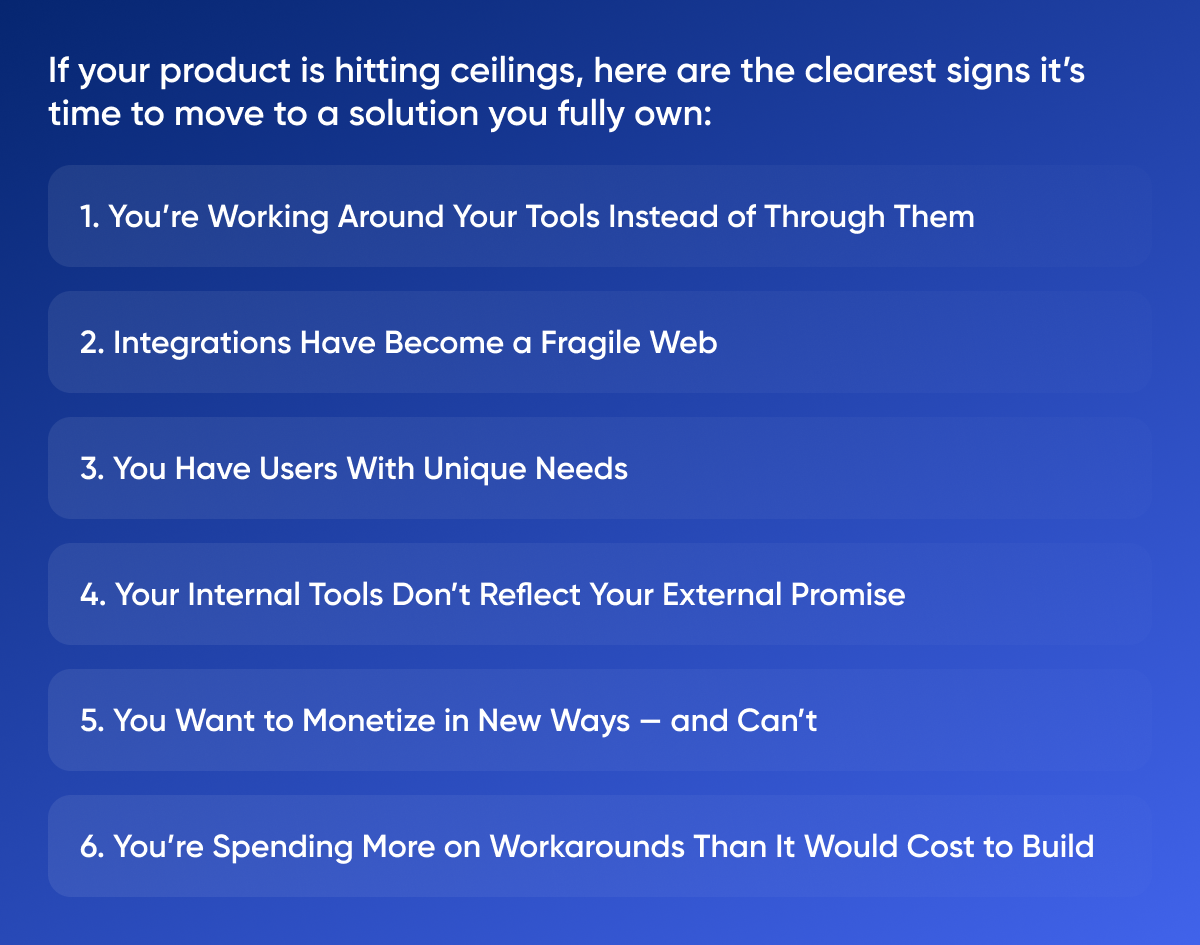Every startup begins with tools — quick integrations, spreadsheets, no-code solutions, and off-the-shelf software. And in those early days, those tools work. They let you move fast, test assumptions, and build without overinvesting.
But at some point, the tools start pushing back. Processes break. Data doesn’t sync. Users get confused. You find yourself duct-taping features, rewriting docs, and explaining away limitations that shouldn’t exist.
That’s the moment you realize: this isn’t just a product anymore — it’s a platform. And it’s time to build it your way.
Custom platform development isn’t about ego or aesthetics. It’s about control, efficiency, and scalability. If your product is hitting ceilings, here are the clearest signs it’s time to move to a solution you fully own.

1. You’re Working Around Your Tools Instead of Through Them
When your daily operations revolve around hacks — copying data between apps, manually resetting things that should be automated, customizing flows outside the product — your tools are no longer serving you.
Off-the-shelf software is designed for mass use. It’s not tailored to your process. And as your product grows in complexity or scale, those “universal” workflows quickly become friction points.
A custom platform lets you encode your logic into your product — making your team faster, your UX smoother, and your customer experience more intuitive.
2. Integrations Have Become a Fragile Web
Startups often build on ecosystems: Stripe for payments, Airtable for data, Zapier for automation, Retool for dashboards. It works — until it doesn’t.
When a single tool update breaks your workflow, or when you spend more time managing integrations than building features, you’ve entered what we call “stack fragility.”
A custom platform doesn’t mean ditching every third-party service. But it does mean building a unified core that you control — one with clean APIs, internal logic, and resilience against platform drift.
3. You Have Users With Unique Needs
Generic tools work best for generic users. But when your customers start asking for specific features, tailored flows, or custom branding — and you can’t deliver — you risk losing them.
Custom platforms allow for personalization, modular feature sets, and adaptive UX. Whether it’s role-based access, granular permissions, or white-labeled dashboards, owning your stack means you can serve your users at the level they expect.
And if you’re targeting B2B or enterprise clients, customization isn’t optional. It’s a competitive edge.
4. Your Internal Tools Don’t Reflect Your External Promise
Startups often focus on the front-end — the app users see. But what about what your team sees?
If your support team is stuck using Google Sheets to manage refunds, or if onboarding a new client requires toggling between five apps, your ops are costing you speed.
A custom platform includes the systems behind the scenes: admin panels, analytics dashboards, permission management, and customer support tools. These systems aren’t just internal luxuries — they’re what keep your business operating smoothly at scale.
5. You Want to Monetize in New Ways — and Can’t
SaaS monetization models have exploded: usage-based pricing, modular add-ons, team-based tiers, metered billing. But implementing these models with prebuilt billing tools can be painful — or impossible.
A custom platform gives you the flexibility to define and adapt your revenue model as your business evolves. Whether that means metering API calls, offering dynamic pricing, or building a self-serve upgrade experience — control equals opportunity.
6. You’re Spending More on Workarounds Than It Would Cost to Build
One of the clearest — and most overlooked — signals is financial. Look at what you’re spending on integrations, duct-taped tools, and support teams needed to patch the gaps.
Now imagine putting that budget toward development that actually simplifies, strengthens, and scales your product.
If your current tech stack is causing drag instead of lift, building your own platform isn’t a risk. It’s the smarter investment.
The Case for Going Custom — the Right Way
Going custom doesn’t mean building everything from scratch. It means taking ownership of your architecture, logic, and product experience.
Start by identifying your core systems: user management, data architecture, billing, workflows. Build these on solid, scalable foundations — modern frameworks, modular design, and cloud-native infrastructure.
Don’t overbuild. You’re not creating an ERP. You’re building a focused, extensible platform that supports your unique value proposition — and can grow with you.
At Movadex, we guide founders through this transition. From MVPs that hit their limit, to fast-growing products that need structure, we design platforms that evolve with clarity, speed, and strength.
Final Thought: When Growth Outpaces Your Stack, Build the One That Fits
Custom platforms aren’t about control for the sake of control. They’re about aligning your tools with your vision. When the software you rely on becomes the thing holding you back, the answer isn’t another plugin — it’s a platform built around you.
You’ve outgrown your toolkit. Now it’s time to own the system.




